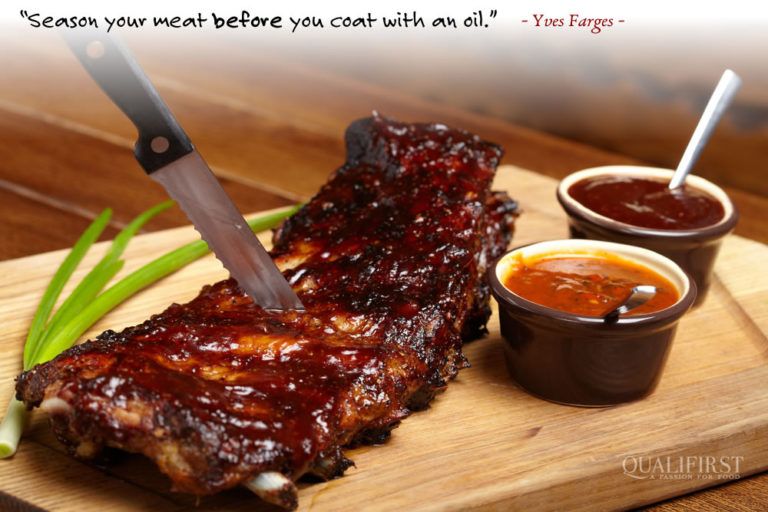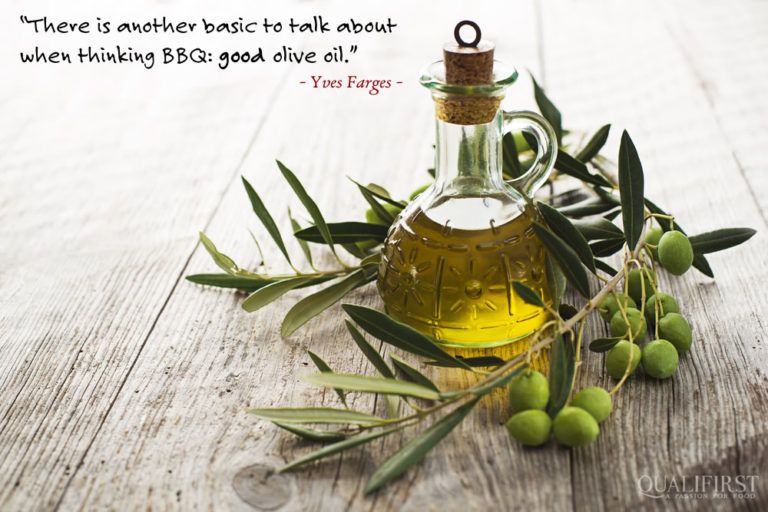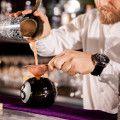BBQ is a primal comfort zone. Cooking something around a fire goes back to all of our ancestors, all successful hunters, cooking meat & vegetables over fire.
It is still popular today, from the serious BBQ pro selecting specific woods & blending secret BBQ sauce recipes to the amateur slapping anything over a fire, careful not to produce coal.
There are hundreds of books on BBQ. This two-part series will cover what is BBQ and then start looking at (great) ingredients that are used to elevate BBQ to a higher level, some would say art. I will also talk about BBQ techniques for dry and wet ingredients, including “How to make your own BBQ Sauce“.

Why does BBQ heat make things tastier?
So how does BBQ – or even cooking for that matter – really work?
Well, this question was answered by a gentleman, Louis-Camille Maillard, who gave his name to the effect: The Maillard Reaction.
The Maillard Reaction (technically)
is a form of nonenzymatic browning. It results from a chemical reaction between an amino acid and a reducing sugar, usually requiring heat.
This makes meat brown when you cook it, gives coffee its dark colour, and also chocolate dark, and on and on …. the examples are endless. A great Canadian example of the Maillard Reaction is Maple Syrup. At sap harvest time, Maple Sugar has a higher amount of trace amino acids.
This reaction is at the base of food preparation and since heat is the pathway … BBQ hangs its hat on the Maillard Reaction. In simpler terms, the reaction is basically sugar molecules reacting with amino acids to produce the amazing odors and flavours we all pursue in food.
Wood fire BBQ purists select the woods for added flavours. For the rest of us mortals, we use a pure heat source such as a gas BBQ (Heathens can also use an oven). We coat the meat or fish or vegetable with something, such as a sauce … and that is where ingredients come in.
History of BBQ Sauce Production:
A generation ago people made their own BBQ sauces. They were family recipes and since the objective was taste, many were amazingly good. Given good ingredients, people can generally make a substantially better BBQ sauce than any you can buy.
With the age of convenience & mass production, some very good BBQ sauces were bottled and sold. Then came the corporations motivated by profit rather than good taste, who promptly changed the bottled BBQ sauce recipes to increase their bottom line, replacing all the good and clever ingredients with sugar, or worse, … High Fructose Corn Syrup (HFCS). The result was basically crap … harsh but pretty close to the truth.
Many people have gone back to making their own BBQ sauces, discovering that it is substantially cheaper, works a lot better, and (of course) tastes better … a LOT better … a LOT LOT better.
What are Great BBQ Ingredients?
Understanding what is going on in a BBQ helps even a complete beginner produce better BBQ. Preparing your BBQ meat and vegetables in advance is the smartest first step. After that let’s talk ingredients, because they will make the biggest difference. Let’s start with salt & pepper … nothing more basic than that.
A simple steak with regular salt and regular pepper tastes fine? Ok, but if people knew that table salt has anti-caking agents such as Magnesium Carbonate and is often heavily processed (de-mineralized), it is just a small step away from road salt. A great sea salt is just better. Pepper is ground industrially and shipped by the ton, losing its punch as time passes until it finally gets to the consumer, just about as dead as the idodized table salt.
Use Maldon Sea Salt or Angelesy Salt plus switch to fresh, whole Tellicherry Pepper from India, that your grind on the spot. Such a small investment and you will rediscover the joy of pepper that actually tastes great. You might use more, but I think that the idea is to get away from corporate processed ingredients that are truly a waste of money.
A side note here. I use a mortar and pestle to grind my spices. There is nothing wrong with a pepper mill but having a mortar and pestle allows you to crush many different spices. It is a purist thing. My mortar & pestle is made of the incredibly hard but light olive wood. Stone works.
One last word about salt and pepper: take the challenge. That steak (or portobello mushroom) you are planning to make? Cut in half and make one with your regular salt & pepper. The other use a good sea salt and freshly ground pepper. Chefs know the importance of proper seasoning. It is for us all to rediscover the beauty of the reality of fundamentally better ingredients … even the simple ones like salt and pepper.
Before we leave salt, currently trendy and crazy-looking is the amazing “Himalayan Pink Salt“. It actually comes from Pakistan, the huge Kehewra salt mine is 300km away from the edge of the Himalayas … but it is a great salt and … so no, sacks of Pink Salt are not trekked in on the backs of Yaks from the Himalayas 🙂
What about Pepper color?
Before we leave pepper, know that black pepper, white pepper, and green pepper are the same plant:
Black is dried & cooked,
White is the washed inner seed, and
Green is the unripe dried & uncooked.
Although India grows the best, it is Vietnam that grows most of the pepper in the world. For my money the white Penja pepper from Cameroon is amazing. The best green pepper is from Madagascar.
The next subject is Herbs:
Rather than write a book on herbs, it is enough to say that Qualifirst has consistently sought out the authentic and aromatic herbs. Classic southern France herbs are Thyme, Basil, fennel, and Savory.
In the spring of 2013 I went to Aix en Provence to track down a real producer to upgrade our herbs, to get the authentic taste. The decision was made to bring in the reality of quality. Ray Martin and his family also trekked there, equally amazed by the aromatic power of “the real herbs de Provence”. When it hit the warehouse in Ontario and in Vancouver, it reminded me of the early days of Far-Met when I was growing up and the “Herbs de Provence” would arrive, filling the warehouse with the south of France.
For BBQ, using these herbs and others, dry or wet, it is smart to understand that these aromas and tastes come from the oil in the plant leaf itself.
Here are some that you can use:
The pine-like zing you get from Rosemary (latin for ‘Dew of the Sea’ BTW …), the sublime subtle Basil, the bright Mint, Tarragon, Oregano (name from Greek ‘Joy of the Mountain’), tiny-leaf Thyme, Coriander (aka Cilantro), Parsley, Chives, Dill, Sage, you get the message, the list is endless.
Some of these herbs are best fresh, but the general usage as an ingredient is to extract the flavour by combining it in a medium, and that ‘medium’ should stick to whatever you are BBQ.
Exceptionally you can put BBQ ingredients inside what is being cooked. Cutting long slits in larger pieces of meet and stuffing them with herbs and garlic is a classic technique. One French technique is the “Gigot D’Agneau” or Lamb Leg, where you use a knife to punch holes all over the meat, sticking slices of garlic in the meat.
Let’s not forget the Oil:
Before we launch into more ingredients from all over the world, since we have talked about salt and pepper and herbs, there is another basic to talk about when thinking BBQ: Oil.

I do mean “good” olive oil. It used to be that cheap olive oils were lower in flavour and inexpensive. Today cheap olive oils are devoid of flavour; some plainly bad. There is a tendency to use marginal oils for BBQ: Bad idea. A slightly rancid oil will flavour your BBQ so buy a good olive oil bulk (cheaper).
Some will ask “What do I use oil for in BBQ?” No matter what you have on the BBQ, there is going to be a lot of heat, which will drive out water from whatever you cook. Sealing in the moisture by either searing the meat on all sides or coating the meat or vegetables with an oil and/or BBQ sauce allows for even heat distribution and less water to evaporate.
A simple way to migrate a smokey taste into both meat or vegetables is a smoked oil.
From Spain we have brought the amazing Castillo de Canena smoked olive oil. Aromatic organic oak, beech, and birch chips are cold-smoked infused, which means the oil is smoked without heat.
Keep in mind that you want to season your meat before you coat with an oil, so that the herb or spice is kept close to the meat. If you salt and spice after you coat the meat with oil, you only flavour the oil, which actually insulates the meat from the tastes of the herbs and spices.
Sorry if this is a little long but it is a big subject. In the second part of this BBQ article I will introduce other BBQ ingredients from Qualifirst and tackle “How to construct a BBQ sauce” which is much more involved than you would think.






